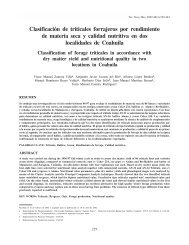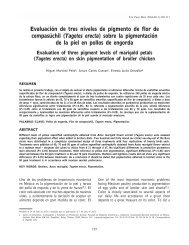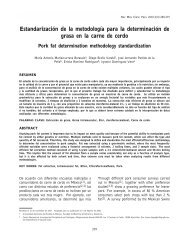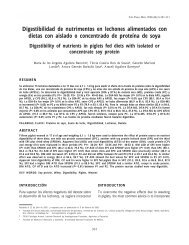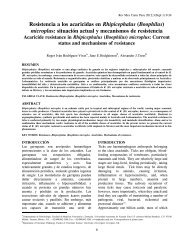Control de Rhipicephalus microplus - Revista Técnica Pecuaria en ...
Control de Rhipicephalus microplus - Revista Técnica Pecuaria en ...
Control de Rhipicephalus microplus - Revista Técnica Pecuaria en ...
Create successful ePaper yourself
Turn your PDF publications into a flip-book with our unique Google optimized e-Paper software.
Melina Maribel Ojeda-Chi, et al. / Rev Mex Ci<strong>en</strong>c Pecu 2011;2(2):177-192<br />
alteraciones <strong>en</strong> varios metabolitos <strong>en</strong>tre los que se<br />
<strong>en</strong>contraban la hemoglobina, glóbulos blancos,<br />
colesterol, albúmina, globulina, amilasa, fosfatasa<br />
alcalina y también es posible que secret<strong>en</strong><br />
compuestos hepatotóxicos.<br />
c) Métodos para el control<br />
Químico<br />
Los químicos disponibles, que se utilizan para el<br />
tratami<strong>en</strong>to <strong>de</strong> ectoparásitos <strong>de</strong> importancia <strong>en</strong><br />
medicina veterinaria, son sistémicos, todos los<br />
ixodicidas son neurotóxicos, y ejerc<strong>en</strong> su efecto<br />
sobre el sistema nervioso <strong>de</strong> los ectoparásitos (18).<br />
Los métodos tradicionales <strong>de</strong>l tratami<strong>en</strong>to ixodicida,<br />
para el control <strong>de</strong> garrapatas requier<strong>en</strong> <strong>de</strong><br />
formulaciones que se diluyan <strong>en</strong> agua y se apliqu<strong>en</strong><br />
por aspersión o inmersión <strong>en</strong> los animales. A<strong>de</strong>más<br />
se incluy<strong>en</strong> los métodos <strong>de</strong> <strong>de</strong>rrame (pour-on),<br />
inyectables, bolos intraruminales, aretes<br />
impregnados con ixodicidas y feromonas (19).<br />
Entre los principales ixodicidas que se utilizan para<br />
el control <strong>de</strong> garrapatas se <strong>en</strong>cu<strong>en</strong>tran los<br />
organoclorados (OCs), OFs, PSs, Am, f<strong>en</strong>ilpirazoles,<br />
reguladores <strong>de</strong>l crecimi<strong>en</strong>to y los <strong>en</strong><strong>de</strong>ctocidas<br />
<strong>de</strong>nominadas lactonas macrocíclicas (LM) (19,20,21).<br />
Sin embargo, el uso indiscriminado <strong>de</strong> estos productos<br />
ha provocado la selección <strong>de</strong> poblaciones <strong>de</strong> garrapatas<br />
resist<strong>en</strong>tes, <strong>de</strong>bido a la fuerte presión que elimina a<br />
los individuos susceptibles, por lo que se disminuye<br />
progresivam<strong>en</strong>te el efecto y se elevan los costos <strong>de</strong><br />
<strong>de</strong>sarrollo <strong>de</strong> nuevos ixodicidas. La resist<strong>en</strong>cia<br />
mundial a los acaricidas se <strong>en</strong>cu<strong>en</strong>tra bi<strong>en</strong><br />
docum<strong>en</strong>tada (22,23).<br />
En el sureste <strong>de</strong> México Rodríguez-Vivas et<br />
al (3,22,23) estudiaron poblaciones <strong>de</strong> campo <strong>de</strong> R.<br />
<strong>microplus</strong> y <strong>en</strong>cu<strong>en</strong>tran que la mayoría <strong>de</strong> los<br />
ranchos estudiados pres<strong>en</strong>taban poblaciones <strong>de</strong><br />
garrapatas con resist<strong>en</strong>cia múltiple a ixodicidas<br />
(principalm<strong>en</strong>te multiresist<strong>en</strong>cia a OFs-PSs-Am).<br />
La resist<strong>en</strong>cia a los PSs fue la más importante, ya<br />
que <strong>de</strong>l 66 al 95 % <strong>de</strong> los ranchos <strong>en</strong> el sureste<br />
<strong>de</strong> México pres<strong>en</strong>tan garrapatas con resist<strong>en</strong>cia a<br />
<strong>de</strong>ltametrina, flumetrina y cipermetrina.<br />
Reci<strong>en</strong>tem<strong>en</strong>te (24,25) se han reportado <strong>en</strong> México<br />
los primeros casos <strong>de</strong> R. <strong>microplus</strong> resist<strong>en</strong>te a<br />
180<br />
c) <strong>Control</strong> methods<br />
Chemical control<br />
Drugs available for the treatm<strong>en</strong>t of ectoparasites<br />
with veterinary importance work systemically. All<br />
ixodici<strong>de</strong>s are neurotoxic, exerting their effects on<br />
the nervous system of ectoparasites (18) Traditional<br />
tick control treatm<strong>en</strong>ts are based on water-soluble<br />
ixodici<strong>de</strong> formulations to be applied by spray or<br />
immersion. Other administration methods are also<br />
used including pour-on, injection, intra-ruminal bolus,<br />
and ixodici<strong>de</strong>-/pheromone-impregnated ear tags (19).<br />
Major ixodici<strong>de</strong> classes used for tick control inclu<strong>de</strong><br />
organochlorinated drugs (OCs), OPs, SPs, Am,<br />
PPs, growth regulators, and the <strong>en</strong><strong>de</strong>ctoci<strong>de</strong>s known<br />
as MLs (19,20,21). Ev<strong>en</strong> though, the indiscriminate<br />
use of these products has resulted in the selection<br />
of resistant tick populations due to the strong<br />
pressure that kills susceptible individuals, so that<br />
the effect of these chemical drugs is gradually lost.<br />
In addition, the <strong>de</strong>velopm<strong>en</strong>t of new ixodici<strong>de</strong>s is<br />
extremely exp<strong>en</strong>sive. Worldwi<strong>de</strong> resistance of ticks<br />
to acarici<strong>de</strong>s is well docum<strong>en</strong>ted (22,23).<br />
In Southeast Mexico, Rodríguez-Vivas et al (3,22,23)<br />
studied field populations of R. <strong>microplus</strong> and found<br />
that most cattle ranches studied had tick populations<br />
with multiple ixodici<strong>de</strong> resistance (particularly to OPs,<br />
SPs, and Am). The most important resistance was<br />
that to SPs, since 66 to 95 % of the cattle operations<br />
studied in that region showed ticks resistant to<br />
<strong>de</strong>ltamethrin, flumethrin and cypermethrin. The first<br />
Mexican cases of R. <strong>microplus</strong> resistant to fipronil (24)<br />
and ivermectin (25) have be<strong>en</strong> reported rec<strong>en</strong>tly, which<br />
emphasizes the need of searching new control alternatives<br />
in or<strong>de</strong>r to reduce the use of ixodici<strong>de</strong>s thus <strong>de</strong>lay the<br />
selection process of drug-resistant tick populations.<br />
Non-chemical control<br />
Non-chemical control methods are based on the<br />
use of animal husbandry practices such as selecting<br />
tick-resistant cattle breeds, grassland managem<strong>en</strong>t,<br />
vaccination, biological control, etc.<br />
Biological control<br />
Biological control is <strong>de</strong>fined as the rational use of<br />
live organisms aiming to reduce the populations of



